10 Giant Menorahs That Will Light Up for Hanukkah in NYC
From Brooklyn to the Bronx, we’ve rounded up the most exciting giant menorahs that will light up throughout the next eight evenings!


 Ebbets Field, opening day, 1913. Image via UCinternational on Wikimedia Commons.
Ebbets Field, opening day, 1913. Image via UCinternational on Wikimedia Commons.
New York City is often focused on newness – particularly in the form of its sporting venues. The United States Tennis Championships at debuted its new retractable roof at Arthur-Ashe Stadium this year in Flushing Meadows-Corona Park, but less was reported on the forthcoming demolition of Louis Armstrong Stadium. Like many others in New York City, Louis Armstrong Stadium will be lost to time, rendered obsolete and replaced by something shinier and new.
Here are 10 former sporting venus in New York City – some still standing, some lost to time.
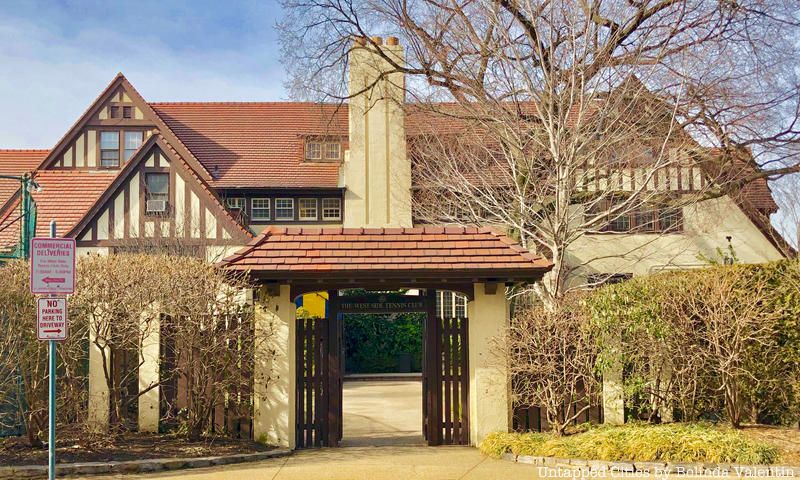
Every year, on the last Monday in August, throngs of people from around the world flock to the US Open to watch the greatest names in tennis compete for a fortnight in the last Grand Slam tournament of the year. The US Open boasts a total of 22 courts and also hosts the world’s largest tennis stadium—the 22,547 seat Arthur Ashe Stadium.
And yet, while spectators watch, bedazzled and engrossed in the serves, slices, and volleys that occur at The Open, few are aware of the former location of the tennis tournament. A now placid, private tennis club in Forest Hills, the West Side Tennis Club hosted the U.S National Championships (it was renamed the US Open Tennis Championships in 1968) from 1915 to 1920, and from 1924 to 1977, after the construction of the 14,000-seat Forest Hills Stadium. It was at Forest Hills Stadium where many of the legends of tennis etched their names in tennis history. Althea Gibson became the first black player to play in a Grand Slam event in 1950, and the first black player to win the tournament in 1957. Billie Jean King the first player to win a Grand Slam event with a metal racket in 1967. Arthur Ashe was the first black man to win a Grand Slam in 1968—concurrent with the first live broadcast of the Open. There was even a shooting and bomb threat in 1977. Moreover, in addition to its usage as the main court for The Open, Forest Hills Stadium has been used as a concert venue for the likes of Frank Sinatra, Bob Dylan, The Beatles, and Donna Summer.
However, for all its glory, the venue had its shortcomings—lack of parking, inadequate food facilities, etc.—and after the U.S Open moved to its current home in 1978, Forest Hills Stadium started to deteriorate, ultimately becoming a forgotten venue. Such was its predicament that in 2010 West Side Tennis ClubWest Side Tennis Club received an offer to demolish the stadium and replace it with condominiums. Despite being fraught with financial issues, the club opted to keep the dilapidated stadium, bowing to community pressure. Since then, the stadium has undergone some renovation and re-opened in 2013 as an outdoor concert venue.
Recently, the venue has hosted a series of regular summer concerts and on February 17, 2016, the newly formed New York Empire of World Team Tennis announced that the stadium would be utilized for their home games, thus completing the stadium’s resurrection as a tennis stadium.
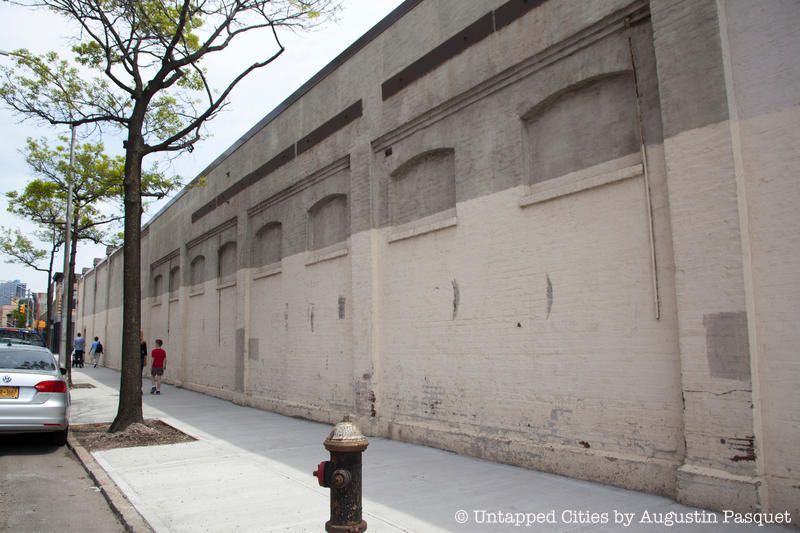 The remaining wall from the Tip-Tops stadium
The remaining wall from the Tip-Tops stadium
Deriving their name from Brooklynites’ reputed proficiency for “dodging” trolleys, the Brooklyn Dodgers played at three sites in South Brooklyn, before moving to Ebbets Field in Flatbush
From 1884 to 1913, Washington Park, located in Park Slope, was the site of three major league baseball parks in which the Dodgers played. The first Washington Park, which was used from 1884-1891, was between Third and Fifth Street, and contained what is now known as the Old Stone House—the location of a deadly battle during the American Revolutionary War and where the lost sport of ice baseball originated.
In 1892 the Dodgers moved to Eastern Park in Brownsville—a newly built stadium that was deemed as a good move. However, the fans regarded Eastern Park as too “eastern” for convenience, and after six seasons of subpar attendance, Charlie Ebbets, the new owner of the Dodgers, moved the team back to the second version of Washington Park. The new 18,800-seat venue hosted the Dodgers from 1898 to 1914. One of the uncommon features of the park was the perpetual stench that permeated the air due to the stadium’s proximity to the nearby factories and the Gowanus Canal, which was a block away.
After the Brooklyn Dodgers moved to Ebbets Field in Flatbush in 1913, the Brooklyn Tip-Tops rebuilt the second Washington Park into a steel and concrete stadium which strongly resembled the initial version of Wrigley Field in Chicago. However, the team was short lived and the stadium was abandoned after two years of use and demolished in 1926. Con Edison acquired the site and converted it into one of their facilities and part of a wall from the Tip-Tops stadium still stands on Third Avenue, south of 1st Street.
 Ebbets Field, opening day, 1913. Image via UCinternational on Wikimedia Commons.
Ebbets Field, opening day, 1913. Image via UCinternational on Wikimedia Commons.
In 1913, the Brooklyn Dodgers moved from their ballpark in Washington Park to the new Ebbets Field in Flatbush, where they played from 1913 to 1957. It was during the 26-year run of the Dodgers in this stadium where barriers were broken and Brooklyn reveled after winning its sole championship. In 1947, Jackie Robinson became the first African American to star in the lineup of a major league baseball game; in 1955 they won their only World Series title.
Ultimately, it was the Dodger’s own success that undermined their position in Brooklyn. With less than 35,000 seats, Ebbets Field was the smallest park in the National League; moreover, there was virtually no room for automobile parking for the fans. Owner Walter O’Malley attempted to secure land at Atlantic Yards for a privately owned domed stadium (the current site of Barclays Center), however he was met with the obstinate opposition of New York City Building Commissioner Robert Moses, who wanted the Dodgers to move to Flushing-Meadows—which O’Malley would not agree to. The Dodgers moved to Los Angeles in 1957 and the stadium was demolished and apartment complexes were built in its place.
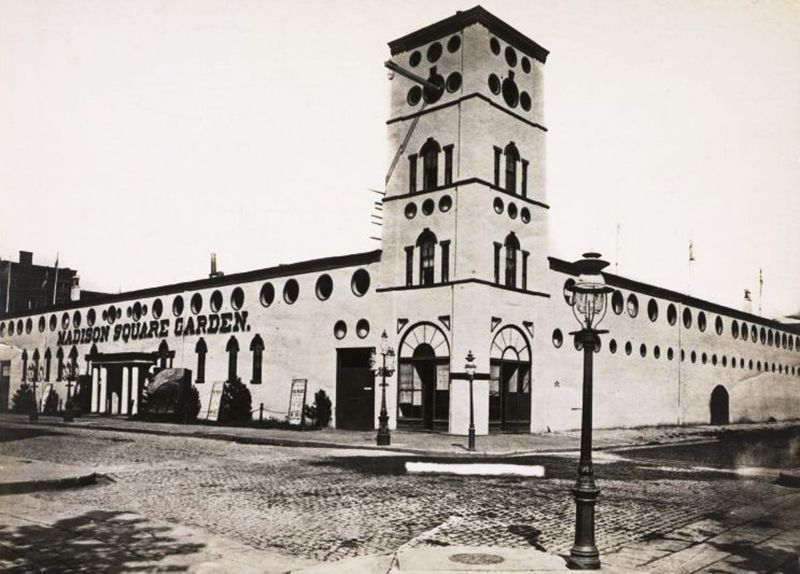
First version of Madison Square Garden. Photo from Wikimedia Commons
Madison Square Garden has been the prime venue in New York City for concerts, conventions, a plethora of sporting events, and spectacles. In addition to being the oldest and most active major sporting organization in the New York metropolitan area, Madison Square Garden is the fourth-busiest music arena in the world in terms of ticket sales.
And yet, the current version of Madison Square Garden, which is situated between 7th and 8th Avenues from 31st to 33rd street, is the fourth venue to be bestowed the name. The first two venues were located just northeast of Madison Square. The first venue was originally built by P.T. Barnum, and known as the Great Roman Hippodrome. William K. Vanderbilt purchased the venue and turned it into Madison Square Garden. It operated from 1879 to 1890 with a capacity of 10,000. While the stadium was used for sporting events, the roofless venue was often blistering hot in the summer and frigid cold in the winter.
The building was demolished and replaced by a new version designed by famed architect Stanford White, which opened in 1890 and was used until 1925. However, the second Garden was also ultimately deemed financially unsuccessful, and the New York Life Insurance Company, which held the mortgage on it, decided to demolish the building in 1925 replacing it with the New York Life Building designed by Cass Gilbert.
The ground-breaking of the third Madison Square Garden, designed by the prominent theater architect Thomas W. Lamb, took place on January 9, 1925. The new venue was used from 1926 until 1961, during the course of which it hosted numerous sporting events, including boxing, basketball, hockey, wrestling and cycling, and Marilyn Monroe’s birthday song to John F. Kennedy. The venue was demolished in 1968, after the current venue was opened.
The present-day Madison Square Garden was built in after Irving M. Felt purchased the air rights from Pennsylvania Railroad and demolished the original Pennsylvania Station—a majestic edifice similar to Grand Central Terminal. The Garden was funded by its core moneymakers: the three-ring circus, Rangers hockey, and Knicks basketball. Over the course of the years the Garden, which boasts the slogan, “The World’s Most Famous Arena,” in addition to hosting its regular sporting events, and concerts for the world’s most famous artists, has been used for various other purposes, such as graduation ceremonies, occasional music award shows, and more.
Still, there is a strong possibility that Madison Square Garden may move again – depending on political will. In 2013, the organization was limited to a 10 year lease at the site, as discussions to improve Penn Station started to take hold.
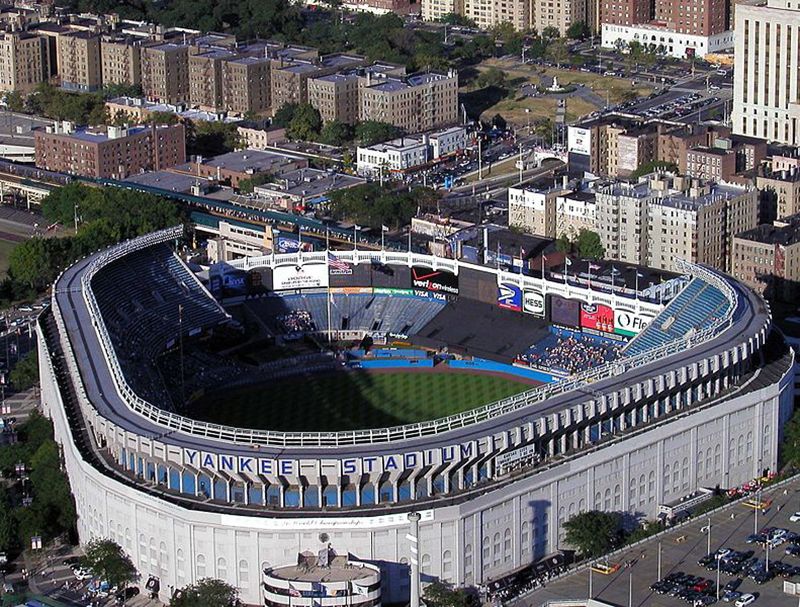
Original Yankee Stadium. Image via Wikimedia Commons by Severin St. Martin
Home to one of the most eminent and decorated baseball teams in history, the former Yankee Stadium—regarded as “The Cathedral of Baseball”—served as the home ballpark for the New York Yankees from 1923 to 1973, and from 1976 to 2008. After having shared a ballpark with the Giants for ten years, owner Jacobs Ruppert was eager to have a stadium of his own; the advent of the stadium coincided with the heydays of Babe Ruth, thus begetting the name, “The House that Ruth Built.”
Yankee Stadium was one-of-a-kind in its days, being the first three-tiered sports facility in the United States, with a capacity of 58,000. Amazingly, the stadium was built in 185 days by 500 workers. From 1936 to 1938, Yankee Stadium underwent some renovations, until 1938, after which the stadium had the “classic” design that it would retain for the next 35 years. By 1970, the stadium had deteriorated, and the Yankees played all of their 1974 and 1975 home games at Shea Stadium, while the stadium was renovated at a cost of $160 million ($672 million in 2014 dollars). This cost was originally shouldered by New York City, but is now being paid off by New York State.
On August 16, 2006, after years of speculation about the future of the stadium, the construction of a new facility began. After the last game of the season was played in September of 2008, tours were conducted before demolition began in March of 2009. Today a 10-acre park, named Heritage Park, sits on the site of the old Yankee Stadium, across the street from the new stadium.
Also, read about the day the Yankees played their last game of football.

Photo from Library of Congress
The Polo Grounds is one of the oldest sporting venues in New York City, built originally for the sport of polo, as the name suggests. It was the name of three stadiums in Upper Manhattan that was home to the likes of the Giants, the New York Jets, the New York Brickley Giants, the Yankees, and the Mets. The New York Giants played at the Polo Grounds from 1880 to 1957. The Yankees played at Polo Grounds from 1913 to 1922, and the Mets called the Polo Grounds home for their first two seasons, 1962 and 1963.
From the late 1940s on, the Polo Grounds suffered from dilapidation, lack of maintenance, and obsolescence. After the departure of the Yankees and the Giants to the Bronx, the baseball Giants ultimately left for San Francisco in 1957. Afterwards, the ballpark was dormant for nearly three years, until the newly formed Titans (present-day New York Jets) and the Mets used it as an interim home. Finally in 1964, the Polo Grounds was demolished—intriguingly with the same wrecking ball that was used on Ebbets Field four years earlier. A housing project was built and opened on the site in 1968.
You can still see the long staircase of the subway station that serviced the Polo Grounds at 155th Street, although it is in pretty bad shape.

Photo from Wikimedia Commons by Metsfan84
Built as a multi-purpose stadium in Flushing Meadows-Corona Park in Queens, Shea Stadium served as the home of the New York Mets from 1964 to 2008 and the New York Jets from 1964 to 1983. After the departure of the New York Giants to San Francisco, and the Brooklyn Dodgers to Los Angeles, New York City was left without a Major League baseball team. In 1960, an agreement was struck between the National League and Mayor Robert Wagner, Jr. that would grant an expansion to the owners of the New York franchise in the abortive Continental League, should a new stadium be built for them. And so, the new stadium was built and named after William A. Shea, the man who brought National League baseball back to New York.
While Shea Stadium was renovated from a multi-purpose stadium to a solely baseball one after the New York Jets left for Giants Stadium in 1964, the ballpark was not optimal for baseball. Since the 1990s, the Mets began talking about moving to a new stadium. Disputes with the city arose during the end of Mayor Giuliani’s term and continued during Mayor Bloomberg’s term over the expenses of building a new stadium, but the final plans for Citi Field were created as part of New York City 2012 Olympic bid. The demolition of Shea Stadium began in October 2008 and the land was used as extra parking space for the adjacent Citi Field.
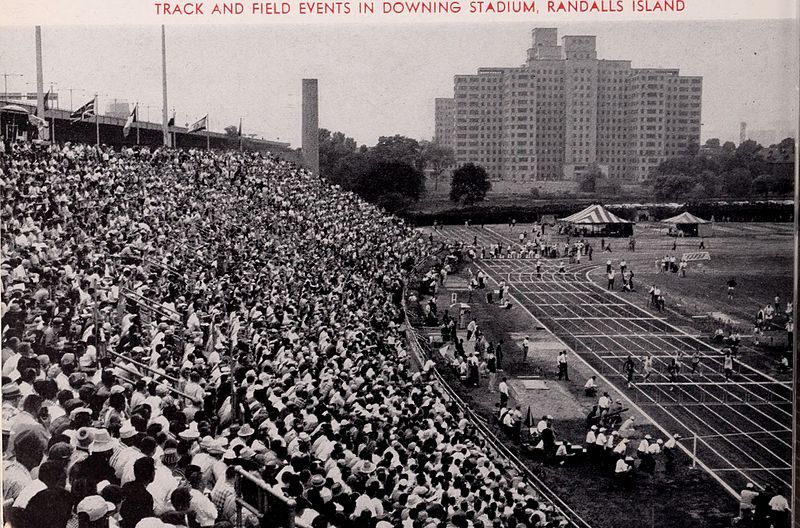
Photo from New York Department of Parks via Wikimedia Commons
Downing Stadium, formerly known as Triborough Stadium and Randall’s Stadium, was built on Randall’s Island in 1935-1936 by Robert Moses. On its opening night, it hosted the Men’s Olympic Trials. Downing Stadium hosted the New York Yankees football team in 1936 and 1937, and the Brooklyn Dodgers football team in 1966; the first televised football game was held at Downing Stadium. Moreover, the stadium was used for soccer events too, namely two international soccer matches, and Pele’s NASL debut against the Dallas Tornado was hosted there too.
Originally, the site was considered for a 48,000-seat soccer stadium, should the United States win the bid for the 2012 London Olympics. In spite of losing the Olympic bid, the stadium was demolished in 2002 and replaced with the new Icahn Stadium in 2004.
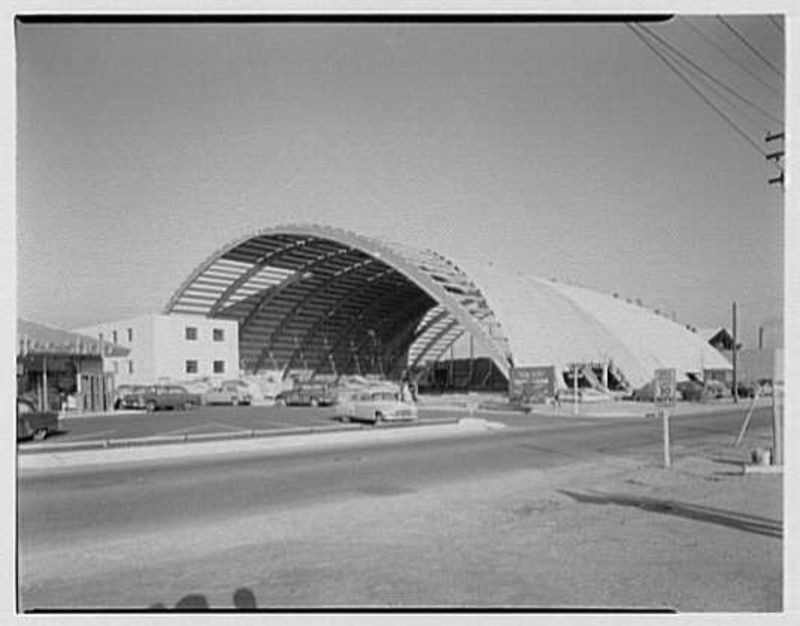 Image via Wikimedia Commons, Library of Congress
Image via Wikimedia Commons, Library of Congress
Built in 1957, Island Garden, situated in West Hempstead, Long Island, was a concert and performance venue that showcased the likes of Bob Dylan, Louis Armstrong and the Family Stone. The venue hosted the New York Nets from 1969 to 1972. In 1973, the arena was partially demolished. A shopping center was constructed on part of the former arena, and a new youth basketball venue was established in 1998.
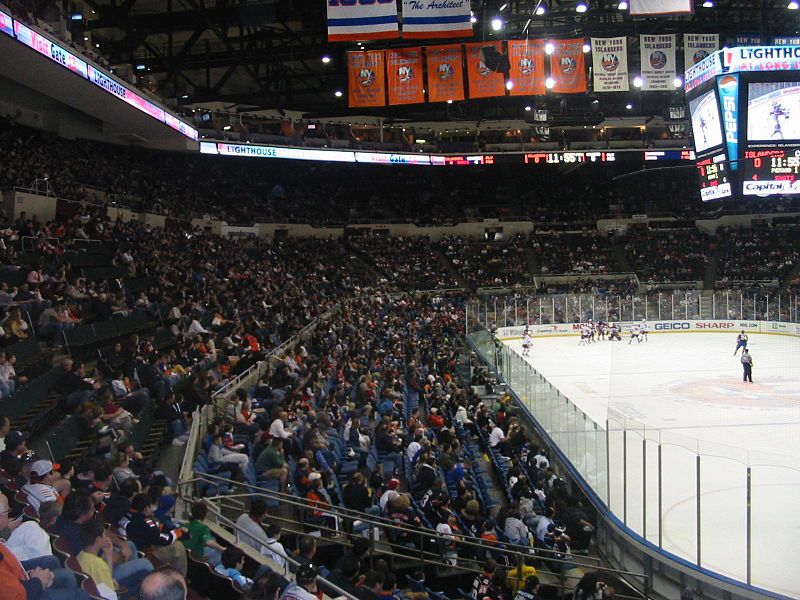
Image via Wikipedia by IMatthew
Located in Nassau County in Long Island, Nassau Coliseum served as the home of the New York Islanders hockey team from 1972 to 2015, and the New York Nets basketball team from 1972 to 1977. In addition to hockey, the arena was also used for WWE Raw and Smackdown numerous times. After the Islanders announced their decision to move to the Barclays Center in Brooklyn following the expiration of their lease in 2015, Forest City Ratner, the owner off the Barclays Center was chosen to conduct a study on development possibilities for Nassau Coliseum. As such, facility is undergoing major renovation until an estimated date of Spring 2017.
Next, see the remnants of the Dodgers in Brooklyn and read about the Top 10 Secrets of Flushing-Meadows Corona Park, where the US Open Takes Place.
Subscribe to our newsletter